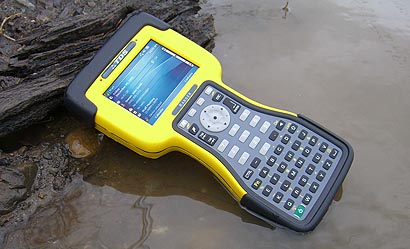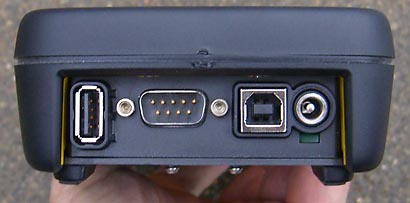|
TDS Ranger 500X
Next generation TDS Ranger better in every way
(by Conrad H. Blickenstorfer)
There are times when you need a handheld computer in the field, but it can't just be any handheld, it has to be one that can take some abuse. It may get dropped or rained on. The job site may be really hot or really cold. Or you may need a decent-sized keyboard or keypad on it, or certain ports for communication or peripherals. For those kinds of jobs, a standard PDA won't do, and even most ruggedized Pocket PCs and handheld terminals aren't up to the task. This is when you need a rugged handheld computer that was conceived, designed, and built for exactly the kind of abuse it is likely to encounter out there in the field. Tripod Data Systems makes such machines.

Yes, we abused our test TDS Ranger 500X. We dropped it. We put it in, and under, water. It survived all tests without missing a beat. [click for larger image]
Ranger -- rugged and state-of-the-art
Take the TDS Ranger, for example. The original model, introduced in 2000, was designed from the start as a rugged handheld for extreme industrial applications. We're talking carbon fiber case with a steel frame inside, and plenty of rubber and polyurethane for protection.
However, the folks at Tripod Data Systems, which was founded back in 1987 and now is a wholly owned subsidiary of Trimble, weren't satisfied with just making tough machines. They also had to be technologically state-of-the-art. Even the original Rangers used the then-new StrongARM processor to provide computing power, and they had reflective color displays so users could actually see the screens when they worked outdoors. TDS also knew that there is nothing more frustrating than to run out of battery in the middle of a job, and so they equipped their handhelds with massive power packs that could, if push came to shove, last for several days. When we reviewed a Ranger 200C in 2002, it not only came with all of the above, but also with 128MB of Flash - an amount almost unheard of in those days -- and it was sealed to IP67 standard, which means complete protection against dust and also protection against accidental immersion into water. And we're not just talking puddles. The Ranger can survive half an hour in three feet of water. Quite impressive.
Windows Mobile 5.0
Given all this, we weren't really surprised when, in February of 2006, the Corvallis, Oregon-based crew announced that the latest version of the Ranger was now equipped with Windows Mobile 5.0, replacing the prior version that ran Windows Mobile 2003. This means that as I was writing this review you could get Windows Mobile 5.0 with its many new features in an ultra-rugged industrial handheld from Tripod Data System, but it was not available yet for my fancy Hewlett Packard iPAQ 4700. So when Tripod says that "the Ranger provides users with the latest handheld computer technology in a rugged form factor, helping them work more productively in the field," they are 100% correct.
Look and feel
What exactly is the Ranger, and how does it look and feel? The first impression is that it is a rather large device. The landscape LCD display that looks pretty small is actually a full 3.8 inches in diameter - the size Pocket PC displays used to be before most of them shrank to 3.5 inches (and less in Pocket PC phones). The Ranger is 10.25 inches long, about five inches wide, and over an inch and a half thick. It weighs over two pounds, almost as much as a small Tablet PC. This is truly the Hummer of Windows Mobile devices. It's also built incredibly well. Over the years we've come across our share of industrial handhelds or rather questionable design and quality. The Ranger is on the other end of the spectrum. It is an attractive, clean design that is perfectly executed. There isn't a single detail that doesn't look like someone hadn't thought about it long and hard, and then made sure that it was just right. And unlike many industrial "tools for the job," the Ranger is not only tough and purposeful, but also impeccably finished.
Superb ergonomics
TDS also paid attention to ergonomics. Despite its size, the Ranger is easy to hold and carry around. Its design is such that it perfectly fits into your hand. And when you hold it, the weight seems perfectly balanced as well. The tough polycarbonate shell is smoothly rounded so that it doesn't cut into your hand anywhere. It looks and feels invulnerable. Add the thick protective rubber boots on the top and bottom of the computer, and the Ranger truly feels invincible. Yet a bit more protection is provided by the Ranger's yellow padded nylon carrybag with adjustable Velcro loops.
Keypad
While the device has a touchscreen, it's really designed for data entry via its large keyboard. TDS thoughtfully separated navigation from the alpha and numeric keypad sections. The numeric keypad keys are large and have the same exact horizontal spacing as those on a full-size keyboard. This makes rapid numerical data entry easy, especially since the dot and delete keys are right next to the numerical keypad as well. The alpha keypad uses a sequential alphabetic layout. Personally, I prefer a thumbtype QWERTY layout, but the Ranger isn't really designed for that. In addition, typing on an alpha keypad is simple. All keys are very clearly marked with white symbols on black or gray keys. All keys provide terrific tactile feedback. A function key provides access to each alpha key's secondary symbol. These are clearly marked in yellow, above each key.
Above the keypads is a very cleverly laid out navigation area. There is a large round 8-way navigation disk with an enter function in its center. There are tab forward and tab backward buttons. There is a separate ESC button. There are also two phone-style function keys underneath the screen. Those will invoke whatever menu function is displayed above it on the screen.
Versatility via "PowerBoot"
The Ranger provides connectivity via its "PowerBoot" module that combine ports and a massive 3.8V/6.6AH battery. The ports are full-size, too: there are two standard USB ports -- one host and one client - and a full-size 9-pin serial port. The PowerBoot is designed as an integral part of the lower part of the computer, and is held in place with two large screws that you open and close with a screwdriver or a coin. The PowerBoot also contains the external power jack. It comes off quite easily and I'd like to see a bajonet lock instead. The protective top-cap - which has a friction groove that holds the stylus -- can also be unscrewed to reveal two CF card slots (one Type I and one Type II) and a SDIO-compatible SD Card slot. This design allows for different types of CF caps. An extended one, for example, can accommodate, and protect, CF cards with extensions such as GPS, scanners, imaging and other oversized cards.
Under the hood
All of this is powered by either a 312 or a 520MHz version of the Intel PXA270 processor. In fact, TDS offers two versions, the Ranger 300X and the Ranger 500X. They differ in processor speed and also in RAM and onboard flash. The 300X comes with 64MB of SDRAM and 256MB of Flash; the 500X has 128MB and 512MB. The 500X comes with Bluetooth which is optional on the lower-end model. WiFi is optional on both models. Thanks to Windows Mobile 5.0, there is now comprehensive persistent storage that eliminates the need for a RAM file system or Sprite Backup. And Windows 5.0 also fully unlocks the potential of the two USB ports.

USB client and host ports, power, and a standard 9-pin serial connector, all properly sealed, of course.
Speaking of Windows Mobile 5.0, when you boot up the Ranger, the screen reminds more of Windows XP than old-fashioned, spartan Windows CE. The Today screen shows WiFi and Bluetooth status, messages, tasks, appointments and access to calendar and contacts. A Windows key reveals the familiar Start menu. The Ranger includes some software one might not expect on a rugged industrial machine. There is, for example, PowerPoint Mobile so you can view PowerPoint slides. Word and Excel Mobile are more powerful than ever, as is Outlook Mobile. There is Pocket MSN, and even a Pictures & Videos application. Just like in a Hummer, when you use a TDS Ranger you're not cut off from civilian perks and conveniences.
Survey Pro software
Our review model came with a copy of TDS Survey Pro. Survey Pro is a land surveying software application for professional surveyors. Survey Pro has numerous optional extension packages that make it suitable for just about any surveying project. And since this is TDS software, it is perfectly mated to both of the TDS handheld computer platforms, the Ranger and the Recon.
Who is the Ranger for?
Who needs the TDS Ranger? If you're in the land surveying business, obviously the Ranger is a natural as it is designed to work well with TDS Survey Pro. However, its performance and ruggedness make the Ranger an excellent choice for many tough jobs in a variety of vertical markets. IP67 sealing, the ability to survive 4-foot drops and an extremely wide operating temperature range from -22 to 140 degree Fahrenheit make the Ranger a great choice for deployment in extreme working conditions. Three expansion slots provide excellent flexibility. And the massive battery offers not just the often demanded "full-shift" capability, but much more than that - up to 30 hours of operation. The Windows Mobile 5.0 platform, finally, is much more robust than anything before, and it even offers conveniences such as standard Microsoft Mobile apps and utilities. Add to that the superb design and execution of this powerful handheld, and its state-of-the-art electronics, and you have a device that is as close to perfect as it gets in this class.
--Conrad H. Blickenstorfer
|



